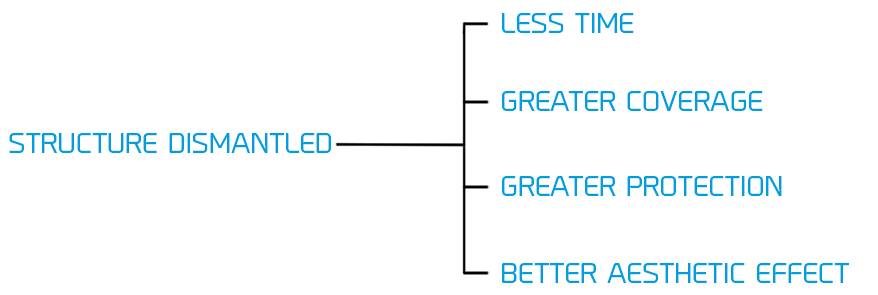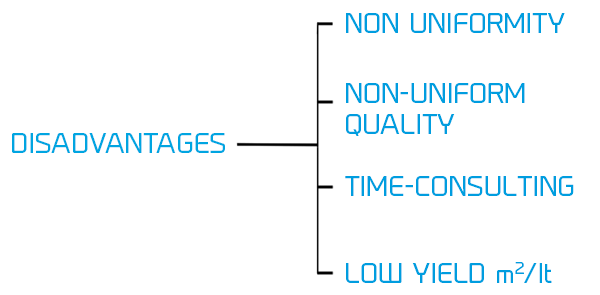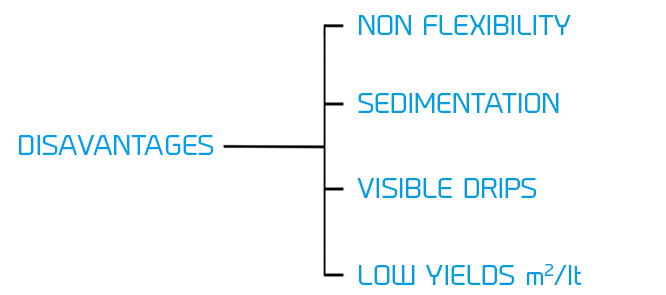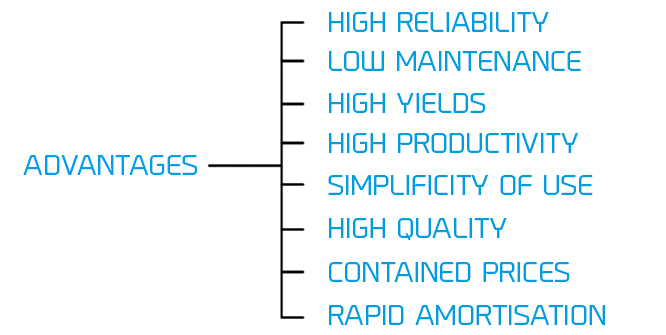IMPREGNATION TECHNOLOGY
Impregnation is the process used to protect wood from atmospheric agents, from the formation of mould and from temperature fluctuations, creating a protective and decorative barrier that gives wood natural breathability, increasing its lifespan and beauty.
Wood, is considered a "living" material which does not remain unchanged over time but undergoes physical and chemical transformations which tend to alter its characteristics. These variations are essentially due to moisture and the action of fungi and bacteria.
The market offers various types of stains: water-based, solvent-based, wax-based and oil-based with various densities that can be comparable with water and even gelatine.
The most common stains produced are resin-, acrylic- and polyurethane-based that penetrate into the wood, protecting it, also against ultraviolet rays, ensuring wooden pieces of furniture, such as structures, roofs, windows, doors, benches, tables, etc. a long life span.
The aspect of decoration that the stain gives the treated element is very important. There are endless colours, types of shine and cover that allow the underlying wood grain to breathe.
L’imprégnation représente un traitement nécessaire en ce qui concerne les structures en bois exposées aux agents atmosphériques. À ce propos des grands progrès ont été fait, et le marché offre des produits qui assurent au bois traité une résistance contre les intempéries et les rayons du soleil pendant une période d'au moins 5-6 ans.
Impregnation is a necessary treatment with regard to wooden structures exposed to atmospheric agents. Great progress has been made in this area and the market offers products that ensure treated wood weathering and sunlight resistance for a period of at least 5-6 years.
Wooden protections in the form of a sort of film are now going out of fashion (such as paints or enamels) and which close the pore of wood, not allowing it to breathe. Within a few months these treatments tend to wear off (the phenomenon of flaking) in patches, leaving the wood completely unprotected in these patchy areas, not to mention the unpleasant aesthetic effect.
The performance of the primer, although being of course variable depending on the type of wood and product density, is considerable and can reach 15-17 m²/L.
The SARMAX automatic impregnating machines of the APACHE line are able to optimally apply any type of stain described above, although the use of liquid products that are easier to apply is becoming increasingly common These types of machine have a primer pumping and spraying action that works with a compressed air line of up at 6bar and as such the use of very dense gelatinous primers is not permitted.
Choosing a SARMAX impregnating machine from the APACHE line, is an excellent investment made by the customer, providing satisfaction and high yield over time, ensuring:
- Important benefits for the user such as reduced cleaning and maintenance times
- An excellent, rapid and cost effective result for the impregnation of your products.
- Low management costs
- Reliability and durability over time
- Rapid and efficient customer service
The SARMAX machines were designed and manufactured on the basis of clear and simple concepts of functionality, maintenance and reliability, making them unique in their kind in terms of conceptual innovations, the main ones being:
- A hood that opens completely, allowing fast and effective cleaning of the inner parts, also by means of a liquid pressure gun connected to the hydraulic system of the same machine
- Positioning of the brushes from the outside during the process without downtime. A single flywheel positions all the vertical brushes while another flywheel positions all the horizontal brushes
- Any dimensional deviations of the workpiece are automatically compensated by the machine devices
- The functional mechanisms are completely outside the impregnation chamber of the semi-finished products
- Various measures to facilitate preparation of the machine in the working and rest position
- The parts that could impair the rotation of the rollers and brushes that come into contact with the impregnation and cleaning liquids are made from a non-oxidisable and non- corrodibile material e.g. stainless steel, aluminium, plastic
- A high-rigidity, electro-welded steel load-bearing frame
- Painting is anti-corrosive and resistant to solvents
In order to ensure perfectly uniform impregnation and simplicity of use our machines are configured in the following manner:
- A front area where the primer is sprayed
- A series of forward-moving counter-rotating brushes
- A number of top and side pressers to ensure perfect workpiece drag
- A device to adjust the feed rate
- A rapid and easy system for the assembly and dismantling of the brushes
- Two tanks: one for the draught and recovery of the stain, the other for depositing of the brushes in liquid when the machine is not being used
- An automatic pump with a draught and filtering circuit for the recirculation of unused primer during the working stage
- A base inside the machine with a high slope for the rapid and effective flow of liquids
Despite the fact that application of the stain can be performed before with the structure dismantled or after with the structure assembled, with modern production and industrialisation processes for the production of wooden structures the system for impregnation with dismantled structure is consolidated.

AVANTAGES

A COMPARISON OF THE VARIOUS TYPES OF IMPREGNATION
Going back a few years, even in an industrial context, the most popular impregnation liquid application systems were with a brush or using dip tanks. These systems have significant drawbacks such as:
- Non-uniformity of product quantities applied to the wooden surfaces to be treated, resulting in different levels of protection (obviously where the product is applied in a lower quantity, the protection is less). For a quicker method using a brush, the product does not usually soak into the slits or into the joints of the beads
- A very poor aesthetic quality with visible accumulations and drippings present on the surfaces and resulting in complaints by customers.
- A very time-consuming activity. In fact, from experimental tests carried out using a brush the average time is 25-30 m2/hour per person (by machine the productivity is 100-150 m2/hour per person)
- A substantial consumption of stain with low performance due to transfers from large to small containers, drips at the application site and various other errors.
- Very limited flexibility in the case of impregnation performed with dip tanks. In fact the amount of fluid used is very high in order to completely submerge the product to be treated. It is essentially used in cases of single colour impregnation.
- Settling of pigments in the immersion tanks resulting in staining non-homogeneities.
A COMPARISON OF IMPREGNATION METHODS
WITH BRUSH

IN TANK

VACUUM

*For outdoor structures such as wooden elements for parks where the degree of protection required is very high this operation is indispensable.

* The consolidated trend is to re-introduce the pieces into the automatic impregnating machine after a phase in the autoclaves because the market prefers a superior finish. This has resulted in the need for an automated impregnation system that avoids these problems.
AUTOMATIC IMPREGNATING MACHINES The initial diffusion of these machines has been slow because the impregnation quality was not optimal, maintenance requirements were frequent and long-lasting and the price was high, making them more convenient in cases of companies with large volumes of timber to be processed.
A decisive step in the evolution of this type of machine was taken a few years ago where a new generation of impregnating machines made life easier for users, where reference could finally be made to a generation of reliable machines with low maintenance, ease of use, extremely high yields and high productivity, giving the possibility of impregnating many m2/hour, almost perfect impregnation quality and contained purchase prices.
NEW GENERATION TUNNEL IMPREGNATING MACHINES:

This evolution has increased the competitive advantage over other systems, increasing their popularity, making this type of machine attractive for small production businesses that employ a limited workforce. In summary, just a few hours of use per week is sufficient to amortise a medium-sized machine in a few months. The operation of these machines is very simple, the application of the liquid takes place in a passing movement where the item to be impregnated enters and exits perfectly impregnated. On the front there is an impregnation chamber where the workpiece is completely sprayed with liquid while in the second part a brushing chamber performs flawless liquid coating.
A series of accessories increase the yield and ease of use, the most important being:
- Blow systems for the cleaning of grooves and beads found on beams
- Rapid brush dismantling system
- Positioning of centralised brushes
- Quick and easy colour change
- Adjustable according to the sizes of the piece
- With the massive spread of impregnating machines, primer manufacturers are increasingly specialising and developing their products to be applied to the machine, including with finishing products.
ECONOMIC ESTIMATE
The purchase of a piece of equipment is the result of a calculation that determines the depreciation time depending on the volume of work to be impregnated. Clearly each company has its own parameters, however in order to provide a series of useful parameters we can summarise the following considerations:
BRUSH IMPREGNATION
Example of cost
- Sale price of impregnated product € 1.50 per bead
- Cost of the impregnation machine € 4.00 per litre
- Labour cost €/h 15.00
- Productivity approximately 25/30 m2/h per person
- The colour yield is approximately 8-10 m2 x l
Example: to impregnate 250 m2
4 hours for 2 people or 8 hours for one person
(15€/h x 2 workers) x 4h = 120 €
Impregnation 250m2 x 2 sides = 500m2 / 10 = 50l
Impregnating cost € 4 x l X 50l = € 200
Therefore
€ 200 + 120 € = 320 € + 30 € of accessory costs = € 350
€ 350 / 250m2 = € 1.4 x m2
Sale price € 1.50 - 1.40 Cost = € 0.10 of Revenue WITHOUT INCLUDING NECESSARY CONTINGENCIES
ALTERNATIVES:
- 1. Reduce the working time and therefore lower the quality
- 2. Use an inexpensive primer and therefore lower the quality
Result
Certain complaints from customers
Non-uniformity of finish
Return and replacement of the contested parts
WITH AN AUTOMATIC IMPREGNATING MACHINE
Now let's look at the same economic estimate calculated however on an automatic machine.
But first two premises:
- The difference in finish and homogeneity is abysmal
- The quality and professionalism of the employee working on the machines is an important factor that could vary upwards or downwards the estimates that we will examine shortly. However its incidence will be imperceptible if compared to that of manual application where staff play a key role.
Example of cost
The yield is 250x 1,80 = € 450
from which we now remove the out-of-pocket expenses that are:
Necessary 45 minutes approximate 1 hour
(€ 15/h x 2 workers) x 2 h = € 30
Primer
(250m2 x 2 sides) : 18 m2/litre = 27.7 litres required
27.7 x 4 €/litre = € 111 approx.
THEREFORE
450-(30+111) = € 309 of revenue per hour of work
From the 309 we remove another € 50 one-off payments for costs and various unforeseen expenses
= € 259/hour of earnings per hour of work of the machine
Considering 1.5 work days per week = 48 hours per month
multiplied by € 259 /hour equals €12,432 per month of earnings
Considering setting aside
50% of the earnings of the machine for depreciation,
the remaining 50% for earnings,
n a time ranging from 200 to 300 hours of work pays off the cost of an average-sized machine.
